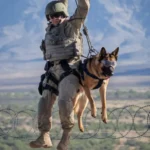The story of Dyngo, a 10-year-old Belgian Malinois, is a testament to the loyalty and bravery of military working dogs.
:focal(2827x1011:2828x1012)/https://tf-cmsv2-smithsonianmag-media.s3.amazonaws.com/filer/65/fd/65fd3c95-c9a7-4fa4-8496-db00f245aca8/janfeb2019_a01_dyngomwdwardog.jpg)
After serving three intense tours in Afghanistan, Dyngo found himself in an unfamiliar setting—my apartment in Washington, D.C. Just three days prior, I had traveled across the country to bring him home for his well-deserved civilian retirement.
On our first night together, Dyngo was a picture of calm. He nestled beside me on the hotel bed, his weight providing a comforting presence as I drifted off to sleep. However, this peaceful moment quickly transformed into chaos. The following morning, Dyngo’s energy surged, leading to an unexpected destructive outburst that left our hotel room in shambles.
With his past as a combat-ready dog, trained to confront insurgents and detect explosives, Dyngo’s transition to civilian life was not as smooth as I had imagined.
While I attempted to keep him entertained, his rough play escalated. Within moments, pillows were torn apart, sheets shredded, and I was left nursing scratches and bruises from his exuberance.
As we made our way to the airport, the mood lightened. Dyngo’s military status earned him applause from passengers, and for a moment, it seemed like we were in sync. Yet, the six-hour flight proved challenging.
Dyngo struggled with motion sickness, vomiting intermittently while trying to shred my Harry Potter blanket—a reminder of his intense past and the lingering effects of his military training.
Upon arriving home, exhaustion enveloped us both, but the tranquility was fleeting. The next evening, I sensed a shift in Dyngo’s demeanor.
His barking evolved into a growl, signaling his discomfort and insecurity in this new environment.
As I stood just a few feet away, my heart raced, replaced by a growing sense of fear. The once-heroic dog now seemed trapped between the remnants of his military past and the reality of civilian life.
Contents
Conclusion
Dyngo’s journey from the battlefield to civilian life encapsulates the challenges faced by retired military working dogs. Their bravery in service is matched only by the hurdles they encounter upon returning home.
As Dyngo adjusted to his new surroundings, it became clear that the path to recovery and adaptation is a long one, filled with both love and challenges. His story is a poignant reminder of the sacrifices made by these incredible animals.
FAQs:
- What is Dyngo’s background?
Dyngo is a 10-year-old Belgian Malinois who served three tours in Afghanistan, where he was trained to confront insurgents and detect explosives. - How was Dyngo transported to his new home?
Dyngo was flown from Luke Air Force Base in Phoenix to Washington, D.C. with the assistance of airport staff and his new owner. - What challenges did Dyngo face in his transition to civilian life?
Dyngo struggled with anxiety and insecurity in his new environment, leading to destructive behavior and bouts of growling and barking. - How did Dyngo’s military status affect his travel experience?
Dyngo received applause from passengers during the flight, showcasing recognition for his service, but he also experienced motion sickness. - What impact did Dyngo’s military training have on his behavior?
Dyngo’s training made him energetic and playful but also led to destructive tendencies, reflecting his adaptation difficulties to civilian life. - What does Dyngo’s story represent?
Dyngo’s story highlights the challenges faced by retired military working dogs as they adjust to life after combat, showcasing their sacrifices and the need for understanding during this transition.








